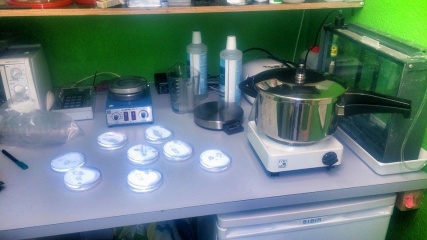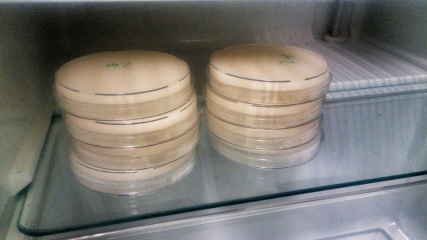Lick the Moonmilk

Hack-Sprint at GaudiLabs and the mount Pilatus in Summer 2014.
Participants: Urs Gaudenz, Felix Bäntli, Medea Gaudenz, Gian Gaudenz, Thomas Vetterli
The Moonmilk
What does Wikipedia say? [1]
Moonmilk (sometimes called mondmilch, also known as montmilch or as cave milk) is a white, creamy substance found inside caves. It is a precipitate from limestone comprising aggregates of fine crystals of varying composition usually made of carbonates such as calcite, aragonite, hydromagnesite, and/or monohydrocalcite.
And there are several hypotheses:
- Is moonmilk the result of bacterial action rather than from chemical reactions?
- Is moonmilk created by the bacterium Macromonas bipunctata?
- Is possible that moonmilk carries dissolved nutrients that can be used by microbes, such as Actinomycetes?
- Is it created by "moon rays" as Conrad Gessner, Swiss naturalist who coined the term "Lac Lunae" back in 1555, thought?
Moonmilk was dscribed as a remedy by Gesner in 1555. Like many other cave contents like bear bones or dripstones, moonmilk was mined and sold by pharmacies. It was prescibed until the 19th century. As it is simply calcite, it definitely cured acalcinosis and probably cardialgia by neutralicing the acid. [2]
This sounds interesting. Let's explore.
Mondmilchloch Lucerm
Luckily the cave Mondmilchloch, where Conrad Gesner first observed and described the moonmilk is in the Pilatus Mountain and not far from GaudiLabs Lucern [3]. The cave seems to be more than 100 meters long and bathed by a stream of water.

How to get there?
Driving from Lucern to Alpnach and then on to Lüdtoldsmatt (Lütoldsmatt). After a curvy road there is a parking and good starting point for the walk. From there on to Schybach, Alp Schy (1336m) then next to Alp Birchboden (1616m). Alp Birchboden is a nice place to have a break after the steep climb. From here on to the Mondmilchloch at 1710m, there is a path with some orange markings on the way. The cave is quite wet and is is best to take with protective clothing or a second set clothes. And of course the usual caving equipment like torches, headlamp and good shoes. Even a helmet can not be wrong.
And of course sterile containers for taking samples of the moonmilk. Or even better a mobile lab:
The Analysis
In deed we found a lot of moonmilk deposits in the cave and took some nice samples. The texture of the deposit is quite unique, slimy and soft, brownish to bright yellowish. And it comes off from the cave wall quite easy. We just removed the cup of the sterile containers and scrape off the moonmilk directly with the edge of the container. Back in the lab we started analysing the samples.
Before the trip already we prepared some culture plates with two different recipes.
Medium 1 - Actinomycetes ------------------------ For 300ml of medium: 5g Glycerol 0.5g NaCl - Salt 20ml Symbioflor 1 6g Agar
Medium 2 - Yummy ---------------- For 300ml of medium: 5g Bimbosan Super Premium 1 5g (1.5 Tabletten) Dextrose 6g Agar
20ml per plate.
The Medium 1 should be selective for Actinomycetes and is based on the description in the publication "Method for the Preferential Isolation of Actinomycetes from Soils" [4]
Glycerol 20g L-Arginine 2.5g (Vitamin) NaCl 2.5 g Salz CaCO2 0.1g Calcium Carbonate FeSO4 7H2O2 0.1g Eisensulfat MgSO4 7 H2O2 0.1g Magnesiumsulfat Agar 20g





Making Agar Plates, Genetic Science Learning Center of University of Utah [5]
Applying moonmilk to the plates
Disolve one small spoon of moonmilk in 100 ml of sterile water. Shake well, it seems to be important to shake very hard to get the bacteria of the stone.
Then we made a dilution series with 1:1 1:10 1:100 and 1:1000 and put 100 ul of each on a culture plate.<br

